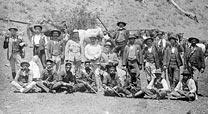Glendon estate
This image viewer requires a web browser with the Flash plugin and JavaScript enabled.
Get the latest Flash player .
Robert and Helenus received land grants of 2000 acres (809 ha) each. They combined their grants to form their estate named Glendon after their home in Surrey. Their land holdings increased after further purchases to around 10,000 acres. According to a history of the area published in the early 20th century, the Glendon homestead was the largest in the district;
‘...the approach to the house was by a gravelled drive bordered by olive and chestnut trees, while the same shady trees were planted as a protection to the big orchard sloping to the river to the right of the house. The remains of a racecourse may be faintly discerned even today…’
Elsie Symonds, A Memoir of Glendon, Sydney: Marchant, 191?
By 1832 Robert and Helenus had acquired more than 300 horses at Glendon. They imported stallions such as Trumpet, Dover and Akbar and bred colonial horses, thus establishing the Hunter’s reputation as a region for thoroughbred studs.
> Read about Robert Scott's involvement in the capture of the Castle Forbes gang of convicts
The estate was sold in the 1840s following a series of financial failures and Robert's death at Glendon in 1844 aged 45. Helenus married Sarah Anne Rusden and settled in Newcastle where he continued his work as police magistrate.
The remaining Scott family, Augusta Maria and her children; Alexander Walker, Augusta Maria, David Charles Frederick and Patrick, also settled in New South Wales. The only daughter of Dr Helenus Scott, Augusta Maria married Dr James Mitchell in 1833. Their son, David Scott Mitchell became one of the most influential book collectors of Australiana and noted benefactor of the Mitchell Library.
> View 'Plan of part of the estate of Glendon ... to be sold at auction', 21 May 1856 ![]()
> View 'Sketch of remaining allotments of Glendon Estate ...' 24 June 1856 ![]()


